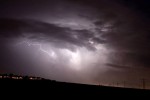A thunder and lightning storm over Nitzan, in the south of Israel. (photo by Edi Israel/Flash90)
New research by an Israeli scientist will likely be crucial to measuring the impact of climate change on thunderstorms. The varying frequency and intensity of thunderstorms have direct repercussions for the public, agriculture and industry.
To draft a global thunderstorm map, Prof. Colin Price of Tel Aviv University’s department of geosciences and graduate student Keren Mezuman used a vast global lightning network of 70 weather stations capable of detecting radio waves produced by lightning – the main feature of a thunderstorm – from thousands of miles away.
“To date, satellites have only provided snapshots of thunderstorm incidence,” said Price, whose new map of thunderstorms around the world is the first of its kind. “We want to use our algorithm to determine how climate change will affect the frequency and intensity of thunderstorms. According to climate change predictions, every one percent rise in global temperature will lead to a 10 percent increase in thunderstorm activity. This means that we could see 25 percent more lightning by the end of the century.”
Price and his team registered the exact GPS time of every detected lightning pulse every hour. The researchers then calculated the difference in arrival times of signals, using data from four to five different stations to locate individual lightning strokes anywhere on the globe. Finally, the researchers grouped the detected flashes into clusters of thunderstorm cells.
The World Wide Lightning Location Network (wwlln.net) is run by atmospheric scientists at universities and research institutes around the world. The TAU team harnessed this ground-based system to cluster individual lightning flashes into “thunderstorm cells.” The WWLLN station in Israel has the ability to detect lightning as far away as central Africa.
“When we clustered the lighting strikes into storm cells, we found that there were around 1,000 thunderstorms active at any time somewhere on the globe,” said Price. “How lightning will be distributed in storms, and how the number and intensity of storms will change in the future, are questions we are working on answering.”
The research was published in Environmental Research Letters.
Israel21C is a nonprofit educational foundation with a mission to focus media and public attention on the 21st-century Israel that exists beyond the conflict. For more, or to donate, visit israel21c.org.

